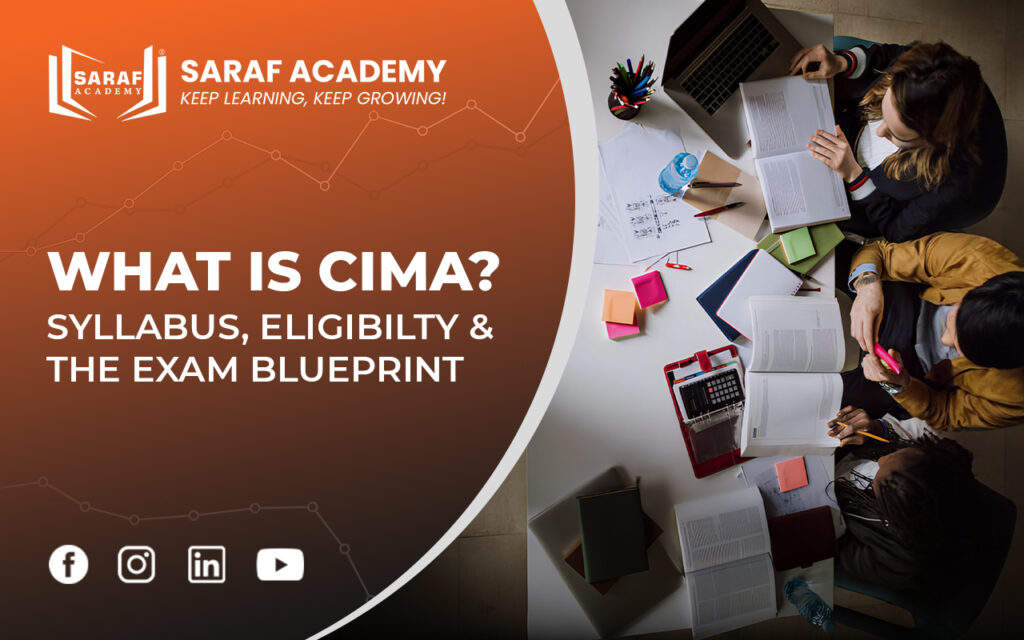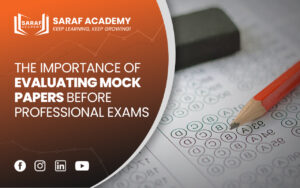

1. What Is CIMA? The Gold Standard for Finance Leaders
The Chartered Global Management Accountant (CGMA) Professional Qualification, awarded by AICPA & CIMA, is the gold standard for finance professionals who want to shape strategy and lead businesses. With the updated 2026 Syllabus and Exam Blueprints, CIMA is evolving to create the next generation of high-impact finance business partners, emphasizing skills in analytics, sustainability, and generative AI.
But CIMA is not just another accounting certification. As Prakash Saraf sir explains, “CIMA is a totally different ballgame than studying any chartered accountancy course.” It is designed to build business leaders, not just technical accountants.
2. Why CIMA? The Saraf Academy Perspective
Many professionals ask, “What job will I get with CIMA?” This is the wrong question.
“I never say that a qualification is going to give you this much job, because that’s not correct,” notes Prakash Saraf sir, who has been teaching CIMA for over 17 years. “We are studying something to get skills and knowledge which are in demand globally. The opportunities in life are other than jobs.”
The true value of CIMA lies in its practical, business-first approach. It’s not a “bookish” study of technical rules you mug up and forget. It’s a pure business case study that integrates every function of an organization:
- Accounting & Finance
- Decision Making & Strategy
- Budgeting, Costing & Risk Management
- HR & Marketing
- Financial Statement Analysis
“After doing CIMA, I have been able to work in my business in a much better way,” Mr. Saraf shares from his own experience. “How to manage business, how to launch products, how to do marketing, how to manage customers… everything I’m doing in my business is because of the CIMA qualification.”
This qualification is future-proof. The 2026 syllabus already covers what businesses will need in the next 3-4 years, taught in a practical, case-study-based manner.
3. Real-World Success: “I Cleared It in One Attempt”
The impact of this approach is best seen through the professionals who have completed the journey.
Take the story of Aditi Mukharhari, SVP and India Lead at Citibank. With 17 years of experience, she was looking to upskill. “I was looking for something which is kind of a global certification… a strategic-driven course and a practical-oriented course,” Aditi shared in an online event.
She chose the CIMA professional route and connected with Saraf Academy. “I literally surrendered myself,” she recalls. “Whatever sir was saying -‘do this many mocks, attend the classes’ – I did. It was very, very practical oriented… I will clear it in one attempt.”
For Aditi, the benefits were clear: “Leadership skill set, looking at the big picture, a very practical-oriented approach in problem-solving… this global certification comes as a feather in the cap.”This is a common theme. Shrey Shah, another Saraf Academy student, scored World Rank 1 in the Management Case Study. “It is only because of two people, Prakash Sir and Vidisha Ma’am,” he said. “It’s because of their constant motivation and the never-give-up attitude that I could actually achieve this.”
4. Understanding the CIMA 2026 Framework (The Pillars)
Success begins with clarity. The CGMA Professional Qualification is structured across three professional levels: Operational, Management, and Strategic.
The syllabus is organized around three core pillars, which build progressively through each level:
- Enterprise (E): Focuses on strategy, organization structure, and change management.
- Performance (P): Covers management accounting, budgeting, and risk management.
- Financial (F): Deals with financial reporting, financial strategy, and governance.
The 2026 updates place a significant new emphasis on:
- Finance Business Partnering: Applying knowledge to support decision-making across the business.
- Analytical & Critical Thinking: Enhancing problem-solving skills in complex business scenarios.
- Sustainability: Integrating topics like green finance, environmental costing, and IFRS S1/S2 disclosures.
Cutting-Edge Technology: Including content on Generative AI and other financial technologies.
5. The Saraf Academy Difference: A Practical, Mentorship-First Approach
At Saraf Academy, we believe in a mentorship model, not just a recorded-video model.
“I always believe in live class, not recording,” states Prakash Saraf sir. “And those live classes are beyond office hours, like 9:00 p.m.”
We understand you are a professional. If you miss a class, the recording is available by default. But the real learning happens through interaction. “If you are sitting beside the camera, I’m not able to see you,” Mr. Saraf says, “but I’m able to see you from here.”
This personal support is non-negotiable. “Whenever you connect with me on WhatsApp… I will not sleep without replying.”
This teaching style adapts to the student. As one professional, who enrolled himself and his son, noted, “When Prakash Sir is teaching to me, he is teaching me like a professional. And when he’s teaching to my son, he’s teaching him like his father.”
6. The “Exam” vs. “Assignment” Misconception (A Critical Correction)
This is the single most important correction professionals need to understand.
Based on the original blog post, you might believe you have to sit for three separate, high-stakes “Objective Tests” (OTs) and a Case Study exam for each level.
This is incorrect for most professional and graduate entry routes.
As Mr. Saraf clarifies: “Actually, CIMA mein kisi ko toh objective type question exam dena hi nahi hai. Woh toh assignment type hai.” (In CIMA, almost no one has to give an Objective Test exam. It’s an assignment.)
For these routes, the OTQ subjects (like E1, P1, F1) are assignments you complete on the institute’s platform. They are not formal exams. There is no pass or fail – if you get a question wrong, the system asks you to solve it again.
“Jo objective type question hai OTQ, E1, P1, F1… woh sab assignments hai,” Mr. Saraf reiterates. “Uske liye koi exams nahi hai.”The only formal, timed exam you need to pass to clear the level is the Case Study Exam. Your entire strategy should be built around this one exam.
7. Your 6-Week Strategy to Pass the CIMA Case Study Exam
Given that the Case Study is the only exam, a 6week preparation plan is unnecessary and inefficient.
At Saraf Academy, we have perfected a 6-week blueprint to ensure you pass on the first attempt.
| Phase | Duration | Focus Area | Saraf Academy Strategy (As per Mr. Saraf’s instructions) |
| Phase 1: Pillar Integration & Analysis | Weeks 1-4 (First Month) | Integrating E, P, & F Pillars using the Pre-Seen Material | Your goal is to cover the Enterprise, Financial, and Performance pillars through the lens of the Case Study. How we do it: 1. Pre-Seen Analysis: We don’t just read the pre-seen document; we dissect it. We link every fact to the E, P, and F pillars. 2. Targeted Study: We focus on the application of syllabus concepts to the specific company and industry in your case. 3. Write-up & Evaluation: You will “study and evaluate… your write-up and explanations.” This is “case study write-up by Prakash Sir,” where your practice answers are personally evaluated to build the correct writing style. |
| Phase 2: Mock Exams & Final Evaluation | Weeks 5-6 (Last Two Weeks) | Exam Simulation & Performance Tuning | This phase is about pure exam simulation. How we do it: 1. Full-Length Mocks: You will sit for multiple full-length, timed mock papers that simulate the real exam environment. 2. Personalized Evaluation: “Mock papers, evaluation, yeh sab.” Each mock is graded with detailed, personalized feedback to fine-tune your performance, manage your time, and ensure you are 100% ready for exam day. |
8. Flexible Entry Routes: Finding Your CIMA Path
CIMA is not a one-size-fits-all qualification. The reason the OTs are assignments for many is that CIMA recognizes prior learning and experience. Here are the most common entry routes discussed at Saraf Academy:
- Undergraduates (12th Pass + Pursuing Commerce):
- Exams: You will complete all three Case Study exams (OCS, MCS, SCS). The OTs are treated as assignments.
- Duration: 1.5 to 2 years.
- Note: You are eligible for the CIMA scholarship.
- *The A Star Program (High-Performing Undergrads):**
- Eligibility: If you are in your final year of a top-tier university and have an average score of 75%+, you may be eligible.
- Exams: You may be eligible to attempt only the Strategic Case Study (SCS) exam.
- Duration: 6-9 months.
- Graduates (B.Com, BBA, etc. – Professional Route):
- Exams: Same as the undergraduate route (OCS, MCS, SCS), with OTs as assignments.
- Note: The scholarship does not apply. You are on the professional fee schedule.
- Senior Executive Professional Route (6+ Years Experience):
- Eligibility: Professionals with 6 or more years of relevant experience.
- Exams: You are exempt from the Operational Level. You only need to pass the Management Case Study (MCS) and the Strategic Case Study (SCS).
- CA / CMA India Members (Gateway Route):
- Exams: As a qualified CA or CMA, you are exempt from all exams except one. You only need to pass the Strategic Case Study (SCS) to earn the CGMA designation.
- C-Suite / Senior Leader Route (12+ Years Experience):
- Eligibility: VPs, Directors, CFOs, etc., with 12+ years of senior strategic experience.
- Exams: You only need to pass the Strategic Case Study (SCS).
Note: This is the C-Suite route, often compared to an Executive MBA. As Mr. Saraf notes, “Investing 25-30 lakh in an Executive MBA… investing here 25% of that amount is far better. They will be able to learn better things by doing CIMA.”
9. CIMA Eligibility & Cost: An Honest Breakdown
The investment for CIMA depends entirely on your entry route. Saraf Academy will help you with the registration process seamlessly, at no extra charge, to ensure you are on the correct path.
Here is an approximate breakdown of the CIMA Institute Fees:
- Undergraduate Scholarship Route: £1204 (for 2 years of subscription, registration, and all 3 Case Study exam fees). This is a bundled fee.
- Graduate / Professional Route (e.g., 6+ Years Exp.): £2360 (for 1 year of subscription, registration, and relevant Case Study exam fees).
- Senior Leader (CSO) Route (12+ Years Exp.): £5416 (for 1 year, includes all materials and the SCS exam fee).
Saraf Academy (SAFP) Training Fees:
Our fees are for mentorship, live classes, personal evaluation, and support until you pass.
- All Three Case Study Levels (OCS, MCS, SCS): ₹1,04,999
- Two Case Study Levels (MCS, SCS): ₹74,999
- Single Case Study Level (e.g., CA/CMA Route): ₹45,999
We also offer EMI options for our class fees, as we believe financial constraints should not stop talent.
10. Your Future in Finance: Make Your Strategic Move
The CIMA qualification is not just an exam; it’s a strategic move to future-proof your career. The 2026 syllabus upgrade ensures you are equipped with the skills needed by modern global businesses – skills in leadership, strategy, and practical problem-solving.
This is a qualification that employers fund for their employees because they see the value. Mr. Saraf says : “50% of students are not paying from their pocket… the organization is paying.”
Partner with Saraf Academy, leverage our proven, personalized, and practical methodology, and commit to this 6-week blueprint. Secure your pass on the first attempt and earn the prestigious CGMA designation!




